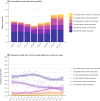Trends and patterns of dual use of combustible tobacco and e-cigarettes among adults in England: A population study, 2016-2024
- PMID: 39842468
- PMCID: PMC11907328
- DOI: 10.1111/add.16734
Trends and patterns of dual use of combustible tobacco and e-cigarettes among adults in England: A population study, 2016-2024
Abstract
Background/aims: E-cigarettes are frequently used by people who smoke. This study measured how the prevalence and patterns of smoking and vaping ('dual use') in England have changed as the vaping market has rapidly evolved.
Design: Representative monthly cross-sectional survey, July 2016 to April 2024.
Setting: England.
Participants: 128 588 adults (≥18y).
Measurements: Logistic regression estimated associations between survey wave and dual use. Descriptive statistics were used to analyse patterns of smoking and vaping, overall and by sociodemographic, smoking and vaping characteristics and harm perceptions of e-cigarettes vs. cigarettes.
Findings: Across the period, the overall prevalence of dual use increased non-linearly from 3.5% to 5.2% of adults [prevalence ratio (PR) = 1.49 (1.25-1.76)]. Among adults who smoked, the proportion who also vaped was relatively stable up to mid-2021, at an average of 18.6% between July 2016 and May 2021, then increased rapidly to 34.2% by April 2024 [PR = 1.76 (1.48-2.09)]. This increase was greatest at younger ages [e.g. from 19.6% to 59.4% among 18- to 24-year-olds; PR = 3.04 (2.28-4.23)]. The most common pattern of dual use across the period was daily cigarette smoking with daily vaping [49.0% (47.3-50.8%)]. Over time, the proportion of dual users reporting daily cigarette smoking with non-daily vaping decreased [from 35.2% to 15.0%; PR = 0.43 (0.29-0.63)], offset primarily by an increase in the proportion reporting non-daily cigarette smoking with daily vaping [from 7.6% to 21.5%; PR = 2.84 (1.71-4.72)]. Daily cigarette smoking with daily vaping was more common (and non-daily cigarette smoking with daily vaping less common) among dual users who were older, less advantaged, mainly smoked hand-rolled cigarettes, had stronger urges to smoke and had been vaping for ≤6 months. Daily vaping was more common among dual users who thought e-cigarettes were less/equally harmful as cigarettes, or were unsure.
Conclusions: In England, vaping prevalence has increased rapidly among adults who smoke since 2021, which was when disposable e-cigarettes started to become popular. Since 2016, patterns of dual use have shifted away from more frequent smoking towards more frequent vaping. This may be the result of increasing prevalence of dual use among younger adults, who are more likely than older dual users to smoke non-daily and vape daily.
Keywords: dual use; e‐cigarettes; population study; smoking; trends; vaping.
© 2024 The Author(s). Addiction published by John Wiley & Sons Ltd on behalf of Society for the Study of Addiction.
Conflict of interest statement
J.B. has received unrestricted research funding from Pfizer and J&J, who manufacture smoking cessation medications. L.S. has received honoraria for talks, unrestricted research grants and travel expenses to attend meetings and workshops from manufactures of smoking cessation medications (Pfizer; J&J), and has acted as paid reviewer for grant awarding bodies and as a paid consultant for health care companies. All authors declare no financial links with tobacco companies, e‐cigarette manufacturers, or their representatives.
Figures


Similar articles
-
Trends in Harm Perceptions of E-Cigarettes vs Cigarettes Among Adults Who Smoke in England, 2014-2023.JAMA Netw Open. 2024 Feb 5;7(2):e240582. doi: 10.1001/jamanetworkopen.2024.0582. JAMA Netw Open. 2024. PMID: 38416490 Free PMC article.
-
Trends in non-daily cigarette smoking in England, 2006-2024.BMC Med. 2024 Oct 24;22(1):426. doi: 10.1186/s12916-024-03635-1. BMC Med. 2024. PMID: 39444038 Free PMC article.
-
Use, perceptions, and effectiveness of e-cigarettes for smoking cessation among older adults in England: a population study, 2014-2024.BMC Med. 2024 Oct 31;22(1):500. doi: 10.1186/s12916-024-03728-x. BMC Med. 2024. PMID: 39482655 Free PMC article.
-
Electronic cigarettes and subsequent use of cigarettes in young people: An evidence and gap map.Addiction. 2024 Oct;119(10):1698-1708. doi: 10.1111/add.16583. Epub 2024 Jun 27. Addiction. 2024. PMID: 38937796 Review.
-
Exploring the Practice of Dual Vaping: Health Risks and Behavioral Patterns in Nicotine and Cannabis E-Cigarette Users.Brain Sci. 2025 Jan 21;15(2):97. doi: 10.3390/brainsci15020097. Brain Sci. 2025. PMID: 40002430 Free PMC article. Review.
Cited by
-
Associations of Close Social Connections With Smoking and Vaping: A Population Study in England.Nicotine Tob Res. 2025 Feb 24;27(3):447-456. doi: 10.1093/ntr/ntae225. Nicotine Tob Res. 2025. PMID: 39315568 Free PMC article.
References
-
- Lindson N, Theodoulou A, Ordóñez‐Mena JM, Fanshawe TR, Sutton AJ, Livingstone‐Banks J, et al. Pharmacological and electronic cigarette interventions for smoking cessation in adults: component network meta‐analyses. Cochrane Database Syst Rev. 2023;2023(9):CD015226. 10.1002/14651858.CD015226.pub2 - DOI - PMC - PubMed
-
- McNeill A, Simonavicius E, Brose LS, Taylor E, East K, Zuikova E, et al. Nicotine vaping in England: an evidence update including health risks and perceptions, September 2022. In: A report commissioned by the office for health improvement and disparities London: Office for Health Improvement and Disparities; 2022. https://www.gov.uk/government/publications/nicotine-vaping-in-england-20... Accessed 3 Oct 2022.
MeSH terms
Grants and funding
LinkOut - more resources
Full Text Sources
Medical
Research Materials
Miscellaneous

